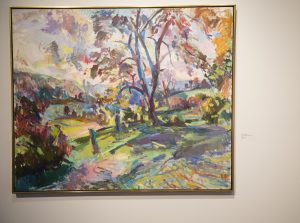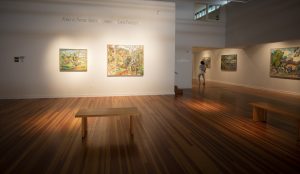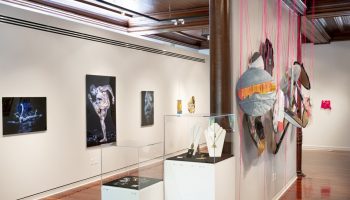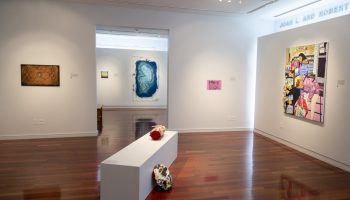One week after Visual Arts at Chautauqua Institution Artistic Director Don Kimes dropped out of graduate school and moved to New York, he cold-called art critic Louis Finkelstein. He asked if Finkelstein would be willing to give him some advice. Kimes didn’t expect a response, much less for Finkelstein and his wife, Gretna Campbell, to become “very important people” in his and his wife’s lives.

“Force of Nature,” an exhibit featuring Campbell and Finkelstein’s landscape paintings, opened with reception Wednesday in Strohl Art Center.
When Kimes called Finkelstein in the 1960s, the critic invited him over and looked at his portfolio. It was Kimes’ second day in New York.
“Is that your car out front?” Campbell asked Kimes.
It was.
“Do you want a job?” she asked.
He did.
Kimes helped the couple move downtown into a SoHo loft. He and his wife, VACI Managing Director Lois Jubeck, gradually became friends with Campbell and Finkelstein. Kimes, who wasn’t previously interested in landscapes, would go out and paint them with Campbell.
“They were both really serious, giving artists,” Kimes said. “Serious and interested in ‘Art with a capital A’ rather than just as a career — you know, the big-picture art. The kind of authentic sense of, not art as a fun thing to do or art as a hobby, but art as a way of life and something that is about what it means to be human.”
Campbell, he said, “was kind of the heart” of the duo, while “(Finkelstein) was the head.”
Kimes wanted Campbell to teach at the School of Art. She was “the first person” he hoped he could bring to Chautauqua, but she passed away in 1987 before that could happen. Finkelstein taught at the school briefly the following year.

“(Campbell) really was a pioneering feminist … first of all, her last name was ‘Campbell,’ not ‘Finkelstein,’ long before people did that sort of thing,” Kimes said. “She was a feminist by example, not by preaching. And (Finkelstein) was an incredibly brilliant Renaissance man. He was interested in science, he was interested in art and he was interested in literature, philosophy. They really were an interesting yin-and-yang couple.”
Campbell, Kimes said, “took everybody under her wing who wanted to be taken under her wing.”
She landed Kimes his first teaching job. He was working as a janitor at the New York Studio School in Manhattan when he ended up, literally, in the middle of a discussion between Campbell and the school’s dean. Campbell, at the top of the stairs, told the dean, near the bottom, that she could no longer work two days a week. She was already teaching two days at Yale as well, and she needed more time to paint.
“It’s October,” the dean said. “Where am I going to find somebody to take the class now?”
Campbell suggested Kimes, who was sweeping the stairs at the time. He got the class.
They ended up teaching together for several years. Kimes recalled one instance in the late 1970s, when he and Campbell were critiquing a student’s work. Kimes was harsh on the student and “went on and on about it,” he said, but Campbell drew attention to one aspect of the painting she loved.
“The student left, and (Campbell) turned to me and said, ‘You can always find one good thing,’ ” Kimes said. “ ‘You need to find one good thing. That gives them something to hold onto.’ ”
Kimes selected the paintings for “Force of Nature” after combing through the Brooklyn storage unit where Campbell and Finkelstein’s children, Henry and Martha, keep them.
“I actually came across some paintings I remembered Gretna was working on when we’d gone out to go and paint landscapes together,” Kimes said. “So that was nice to see those, 40 years later.”
While at first glance the artists’ landscape paintings seem similar, Kimes believes their “head and the heart” dynamic is evident in their work.
“(Finkelstein’s paintings) are the ones that have this intense, high-key color; there’s a lot of figuring out,” Kimes said. “And in (Campbell’s), you can feel the weight of the atmosphere. You can look at those paintings, and you know what the air smelled like. That was their personalities, too.”
Kimes said Campbell and Finkelstein taught him the importance of integrity, and that “art and life come before the business of art.”
“What drives me crazy here is the question, ‘How many people do you reject?’ ” Kimes said. “That is not a measure of success. That’s wrong … instead, it’s like, ‘How many people have you helped? How many people can you help?’ I learned all of that from them.”




